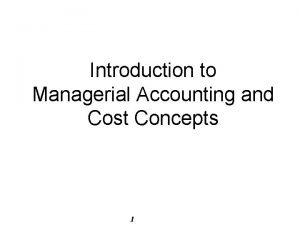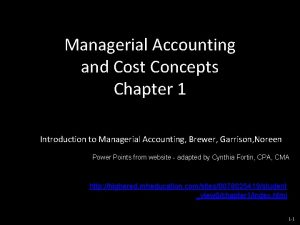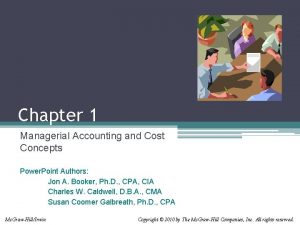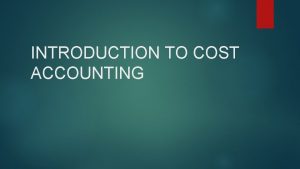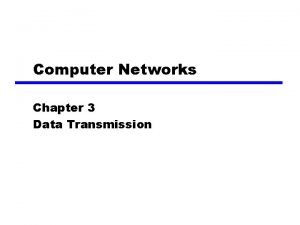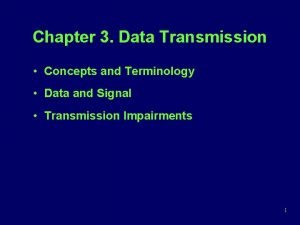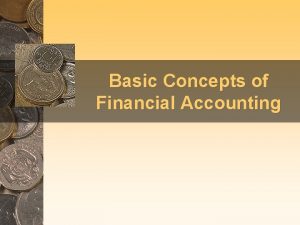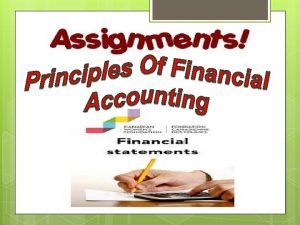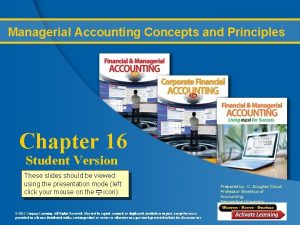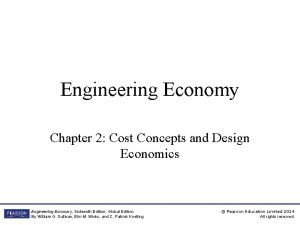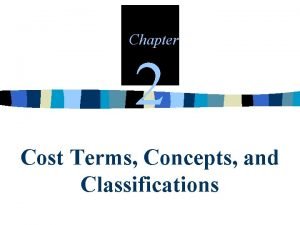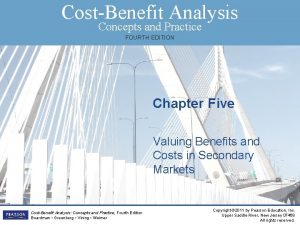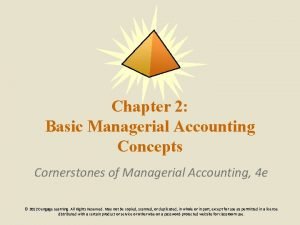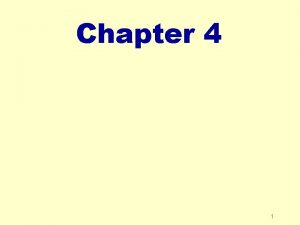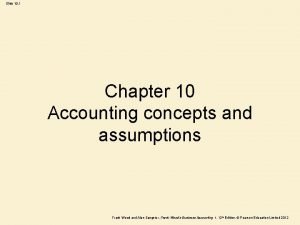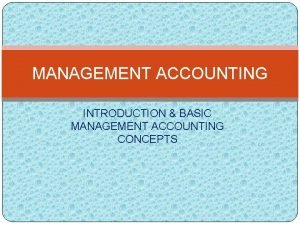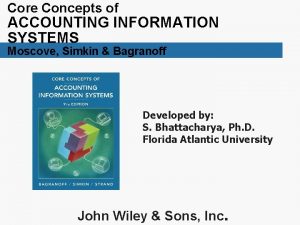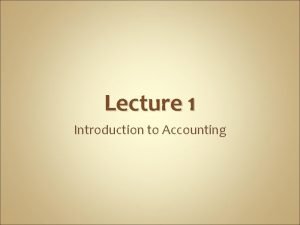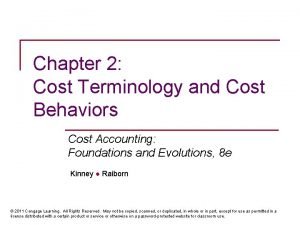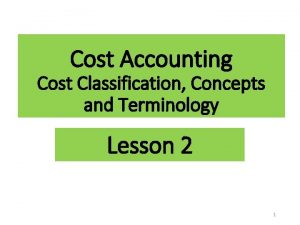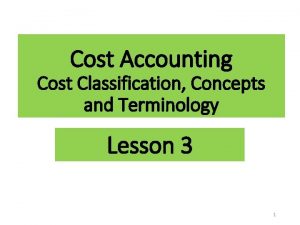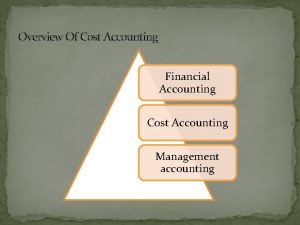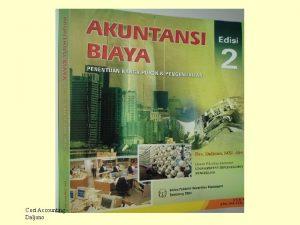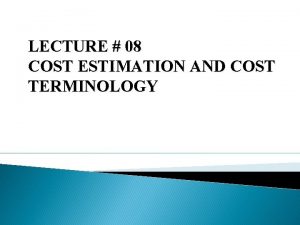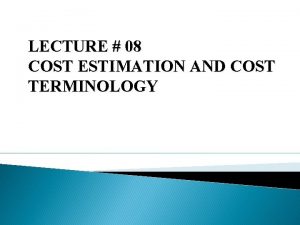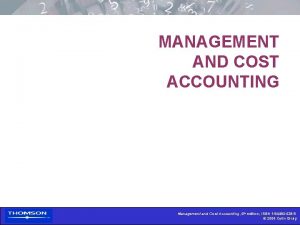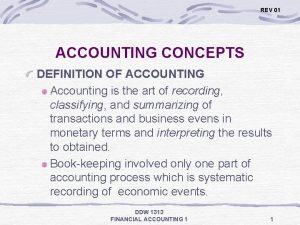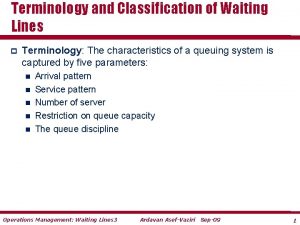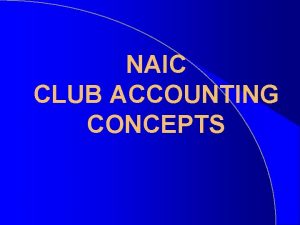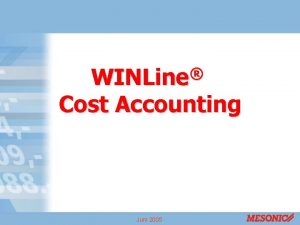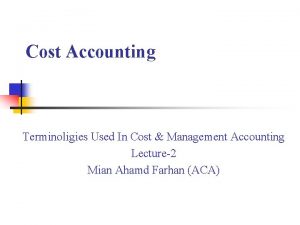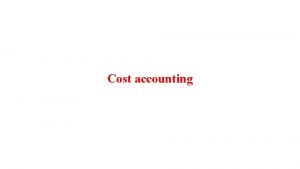Cost Accounting Cost Classification Concepts and Terminology Lesson

























- Slides: 25

Cost Accounting Cost Classification, Concepts and Terminology Lesson 1 1

Explain the general nature of cost accounting and its importance in financial decision-making 2

Question What is the major objective of accounting? 3

Major Objective of Accounting • It is to provide sufficient information to meet the needs of various (both external and internal) users, such as creditors, government, employees and managers. • The information provided will assist them in making decisions. 4

Two Main Scopes of Accounting Financial Accounting Management Accounting Cost Accounting 5

Two Main Scopes of Accounting There are two main scopes of accounting 1. Financial accounting is concerned with the provision of information to external parties. 2. Management (Cost) accounting is concerned with the provision of information to people within the company for making better decisions. 6

Financial Accounting Financial accounting keeps track of a company’s financial transactions. Using standardised concepts, principles and standards, the transactions are recorded, summarised, and presented in a financial statement such as an income statement or a statement of financial position. 7

Cost Accounting Cost accounting is defined as the process of recording, classifying, summarising, allocating and analysing the different alternative measures to control costs. Its purpose is to guide management on how to control costs effectively and maximise productivity / profitability. It provides detailed information of the costs that needs to be focused on and find out the alternative course of actions to control the costs in the future. 8

Comparison of Financial Accounting and Cost Accounting Users Financial Accounting Cost Accounting Provide information to external users (Shareholders, lenders, etc. ) for decision-making. Provide information to internal users (Managers) for planning and controlling the organisation Time Focus Historical perspective Future emphasis Types of Past information Information Both past recorded and future forecasted information 9

Comparison of Financial Accounting and Cost Accounting Financial Accounting Features of Objectivity and Information verifiability of data are emphasised Cost Accounting Relevance and flexibility of data are emphasised Time Span Financial statements are Timeliness of information is prepared on a regular required. Reports are basis required whenever needed Subject Focus on the whole organisation Focus on particular segments of an organisation 10

Comparison of Financial Accounting and Cost Accounting Financial Accounting Standards Follow the GAAP and prescribed format Legal Mandatory external requirement reports Cost Accounting Need not follow the GAAP or any prescribed format Not mandatory 11

Importance of Cost Accounting 1. Determine the cost of a product in order to accept or reject an order at a special price. 2. Determine whether a component will be bought externally or made by the company itself in order to maximise the profit. 3. Determine whether to eliminate or retain an unprofitable segment. 4. Determine whether to retain or replace equipment. 5. Determine whether to sell or process further. 12

Classwork Peter Chan, the financial controller of ABC Company, has come across the following situations in the past few months: 1. Susan Tam, head of the production department, wondered whether it would be more profitable to buy components from an outside supplier or continue to produce by the company itself. 2. The president of the company reminded Peter that the Board meeting was coming up, and he needed Peter to present the information extracted from the financial statements of last year. 13

3. Alan Chan, head of the marketing department, had been approved to expand the sales office in next year. He then estimated and sent related information to Peter for budgeting purpose. 4. Peter received the information from Alan on depreciation and added it to depreciation expenses and accumulated depreciation on office equipment. 5. Peter compared the estimated spending on wages and salaries used in production with the actual spending. He found out that the spending was significantly higher than expected. He called for a meeting with Susan so that he could explain it. Required: Determine whether each of the above situations belongs to cost accounting scope or financial accounting scope. 14

Classwork – Solution 1. 2. 3. 4. 5. Cost accounting Financial accounting Cost accounting 15

Explain the meaning of different cost concepts and terminology 16

Cost Concepts Cost • It is defined as the amount of expenditure incurred on, or attributable to, a specified product or activity. • It is normally made up of three elements: materials, labour and overheads. • For example: Suppose that ABC Company manufactures hockey sticks. Raw materials of wood, paint, and resin costing $40, 000 were put into production. Wages of factory workers amounted to $56, 000 and the depreciation expenses of machine totalled $90, 000 were incurred. In this case, the costs of the company in the production of hockey sticks would be $186, 000 (which included raw materials $40, 000, labour $56, 000 and overheads $90, 000). 17

Terminology Cost Object • It is any item for which costs are measured and assigned. It can be a product, a customer, a department, a project, and so on. • For example: If a bank wants to determine the cost of maintaining credit cards to customers, then the cost object is the credit card. All costs associated to the card are added in, such as the cost of mailing the card to customers, the cost of telephone lines dedicated to the card, etc. 18

Terminology Cost Unit • It is a quantitative unit of product or service in which costs are ascertained. • It is a measurement unit to express the cost of a quantity. • For example: If a bank provides hotline services to its customers, the cost unit will be the number of call received or the number of customer served. 19

Terminology Accumulating Costs • It is the way that costs are measured and recorded. • By cost accumulation, it tells the company the total amount spent on a particular cost object at the end of each accounting period. • For example: When the company receives a phone bill, the bookkeeper records an addition to the telephone expense account and an addition to the accounts payable account. In this way, the cost on telephone charges is accumulated. 20

Terminology Assigning Costs • It is the way to link a cost to its cost object. • By cost assignment, it tells the company how the money is spent on different cost objects. • For example: Of the total phone expenses, how much was for the sales department, and how much was for the manufacturing department? By doing cost assignment, the company can tell whether the money spent on phone calls was to support the selling or the manufacturing of the product. 21

Terminology Cost Driver • It is the basis that is used to allocate costs to cost object. • It is commonly used to assign overheads to the number of units produced. • For example: A factory has a machine that requires maintenance. The management can use machine hours as the cost driver to allocate the maintenance expenses to the costs of products produced by that machine. 22

Key Points Covered 1. The general nature of cost accounting and its importance in financial decision-making. 2. The differences between cost accounting and financial accounting. 3. The meanings of cost, cost object, cost unit, costs accumulation, costs assignment and cost driver. 23

Homework: Q 1 24

END 25
 Managerial accounting and cost concepts
Managerial accounting and cost concepts Relevant range managerial accounting
Relevant range managerial accounting Chapter 1 managerial accounting and cost concepts
Chapter 1 managerial accounting and cost concepts Introduction of cost
Introduction of cost Concepts and terminology
Concepts and terminology ñ
ñ Transmission terminology
Transmission terminology Basic concepts of financial accounting
Basic concepts of financial accounting What do you mean by accounting conventions
What do you mean by accounting conventions Chapter 2 analyzing transactions answer key
Chapter 2 analyzing transactions answer key Accounting principles and policies
Accounting principles and policies Accounting principles and concepts
Accounting principles and concepts Engineering economy 16th edition chapter 2 solutions
Engineering economy 16th edition chapter 2 solutions Cost classifications
Cost classifications Cost-benefit analysis concepts and practice
Cost-benefit analysis concepts and practice Conversion cost formula
Conversion cost formula Accrual accounting concept
Accrual accounting concept 10 accounting concepts
10 accounting concepts Management accounting concepts
Management accounting concepts Core concepts of accounting information systems
Core concepts of accounting information systems Basic management accounting concepts
Basic management accounting concepts Arun and balu are partners in a firm
Arun and balu are partners in a firm Basic accounting
Basic accounting Cost principle accounting
Cost principle accounting Accrual accounting principles
Accrual accounting principles Cost terminology
Cost terminology
